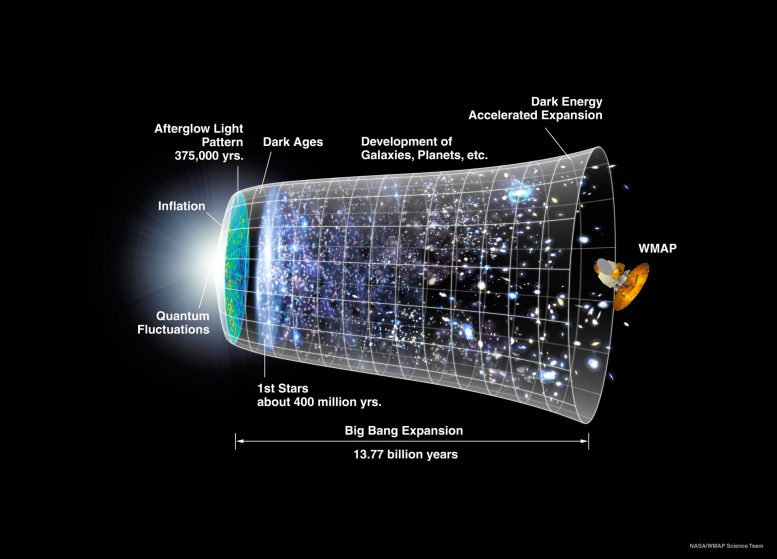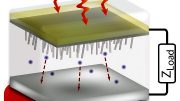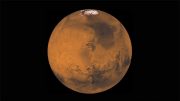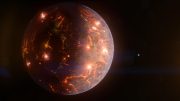By comparing the predictions of state-of-the-art supercomputer simulations with the results of sophisticated statistical analyses of the cosmic background radiation, two independent studies are challenging the cosmological model.
Astronomers Professor Chris Collins and Dr. Ian McCarthy from LJMU’s Astrophysics Research Institute are challenging the view that the currently preferred cosmological model of the Universe is correct.
They are comparing recent measurements of the cosmic background radiation and galaxy clusters in two independent studies partly funded by the Science and Technology Facilities Council.
One of the cornerstones of the Big Bang theory of the Universe is the cosmic background radiation (CBR). Discovered in 1965 these electro-magnetic waves bombard the Earth continuously from all directions at harmless microwave frequencies. However, the radiation arriving here has been cooled to only 2.7 degrees above absolute zero (as it traverses deep space) by the expansion of the universe; therefore, in the distant past the temperature would have been much higher. This leads us to the conclusion that the Universe had a hot origin – the so-called Big Bang – nearly 14 billion years ago.
The Planck Surveyor satellite, launched in 2009 by the European Space Agency (ESA), is the latest in a line of several satellites designed to measure the temperature variations in the CBR from place to place across the sky. These tiny fluctuations slowly grow over time, eventually forming the stars and galaxies we see today. Because the radiation began its journey when the Universe was only 380,000 years old, these measurements provide vital information about the detailed composition of our Universe. The cosmic census provided by Planck is remarkably precise, giving us amongst other things accurate estimates of: the age of the Universe (13.82 billion years) and the amount of dark matter (31.7%) and dark energy (68.3%).
It turns out that Planck is also sensitive to the largest gravitationally bound structures called clusters, which contain thousands of individual galaxies and large amounts of dark matter. Curiously, however, Planck has found fewer clusters than was predicted based on the CBR cosmological analysis.
Now, in independent studies, the recent work of both Collins and McCarthy confirms the “Planck-cluster problem” in that there are much fewer massive clusters in the Universe than expected for the Planck best-fit cosmology, a result inviting a rethink of the underlying model.
Professor Chris Collins explains: “We already knew that the number of clusters found by the satellite was lower than expected and we have now tested this by analyzing a new carefully constructed independent survey of some 1000 clusters over a large area of the sky using X-rays rather than microwave radiation. Our findings confirm that the number of clusters is about a factor of two below the prediction based on the Planck CBR analysis.”
In a separate study, Dr. Ian McCarthy, his LJMU Ph.D. student Amandine Le Brun, and collaborators examined the detailed statistical properties of the CBR and arrived at the same conclusion.
Dr McCarthy explains: “We’ve taken a completely different approach to previous studies, by comparing the predictions of state-of-the-art supercomputer simulations with the results of sophisticated statistical analyses of the CBR. The comparison itself is quite straightforward and avoids any potential issues having to do with identifying clusters and measuring their masses.”
The discrepancy in the predicted and observed number of massive clusters strongly suggests that either the detailed budgeting of the standard cosmological model by Planck is not correct, or that the model itself is flawed in some way. In the latter case, one exciting possibility is that the deficit of galaxy clusters is pointing to an important contribution to the energy budget of the Universe by massive neutrinos, ghostly particles that interact with normal matter only very weakly. Particle physicists have long argued that neutrinos may have non-zero mass, but laboratory experiments have only managed to place relatively weak bounds on what the size of the mass is. McCarthy is planning to carry out large-scale simulations that include the effects of massive neutrinos on cluster formation.
Collins’ work is carried out in collaboration with Professor Hans Bohringer and Dr Gayoung Chon from the Max Planck Institut fur Extraterrestrische Physik, Garching Germany, and is to be published in Astronomy and Astrophysics.
McCarthy and Le Brun’s work is carried out in collaboration with Prof. Joop Schaye from Leiden Observatory Netherlands and Dr Gilbert Holder from McGill University Montreal Canada and is to be published in Monthly Notices of the Royal Astronomical Society.
References:
“The extended ROSAT-ESO Flux Limited X-ray Galaxy Cluster Survey (REFLEX II) IV. X-ray Luminosity Function and First Constraints on Cosmological Parameters” by H. Böhringer, G. Chon and C.A. Collins, 10 October 2014, Astronomy & Astrophysics.
DOI: 10.1051/0004-6361/201323155
arXiv:1403.2927
The thermal Sunyaev Zel’dovich effect power spectrum in light of Planck” by Ian G. McCarthy, Amandine M. C. Le Brun, Joop Schaye and Gilbert P. Holder, 17 April 2014, MNRAS.
DOI: 10.1093/mnras/stu543
arXiv:1312.5341










After the Big Bang explosion, it seems that only Dark Matter and Dark Energy have been racing in the expansion of the Universe, and the stars,galaxies and planets of the visible Universe is nothing but the trickle of this expansion. The initial energy of the big bang of the order of 10^19 Gev, is quite high and it accounts for the Cosmic Background Radiation, accounting for only 2.7 degree Kelvin now , suggesting a very high temperature in the initial stages. Most of the initial energy is exchanged for Dark Matter and Dark Energy in not a conspicuous visible form and only the trickle is found in the real visible Universe. Here you can account for the invisible neutrinos also which went invisible and hidden in the Universe.Thank You.